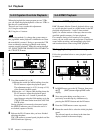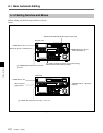
Chapter 6 Editing 6-1
Chapter 6 Editing
Chapter 6 Editing
6-1-1 Overview of Automatic
Editing
Automatic edit modes
The VTR provides the following two modes for
automatic editing:
• Assemble mode
New scenes are added to the end of previously
recorded scenes.
CTL signals, time codes, video and audio signals on
tape in the player are recorded onto tape in the
recorder VTR.
• Insert mode
New scenes are inserted into the middle of previously
recorded scenes. CTL signals on tape in the recorder
VTR are not overwritten. Video, digital audio, cue
audio, and time code signals can be recorded
separately.
Both of these two edit modes support DMC editing.
In insert mode, you can also use split editing.
Interpolation of time codes by the CTL
counter
To use time codes as addresses of edit points, the time
codes must be recorded on the tape in ascending order.
As long as they are in ascending order, time codes do
not have to be continuous. The CTL counter
automatically interpolates data for editing even if there
are breaks in the continuity in the time codes.
6-1 Basic Automatic Editing
Steps in automatic editing
The sequence of steps that are taken to do automatic
editing with two VTRs is as follows:
Select the edit mode (page 6-3).
.
Set edit points for the recorder and player VTR
(page 6-3).
.
Preview the edit section (page 6-9).
.
Perform the edit (page 6-12).
.
Confirm and modify the edit points
(pages 6-8 and 6-10).
.
Confirm the results of the edit (page 6-13).
Editing precautions
Using an editing control unit
When using an editing control unit to control the VTR,
set the edit delay on the control unit so that CUT-IN
and CUT-OUT commands are sent to the VTR five
frames ahead of the actual edit point.


















